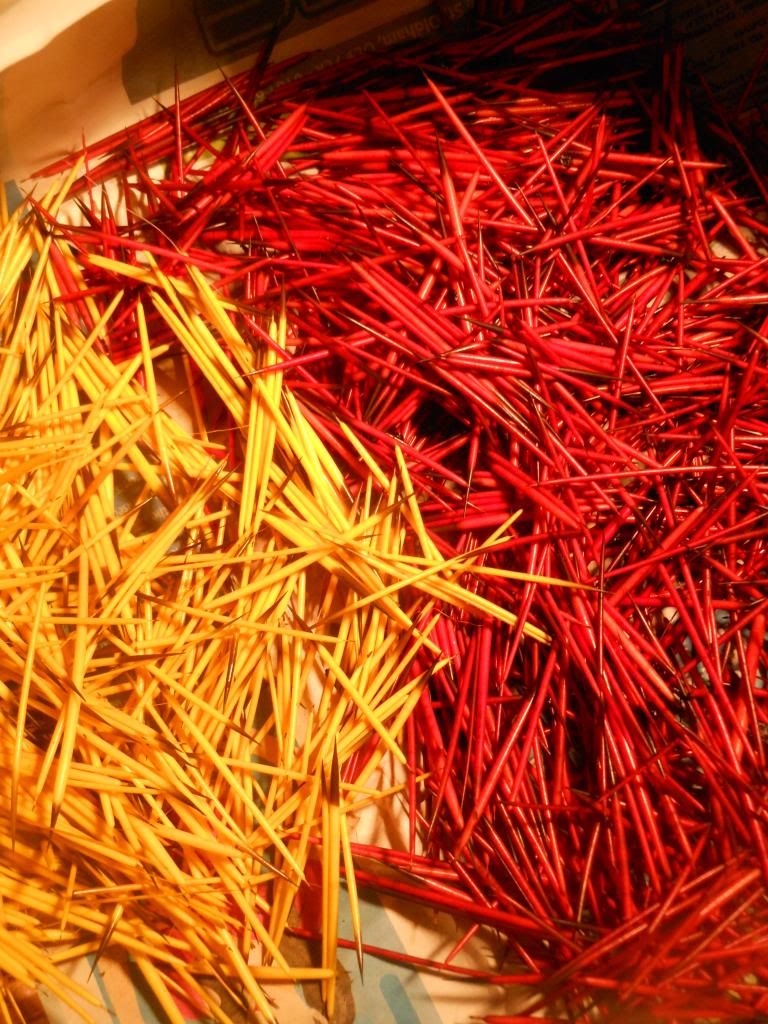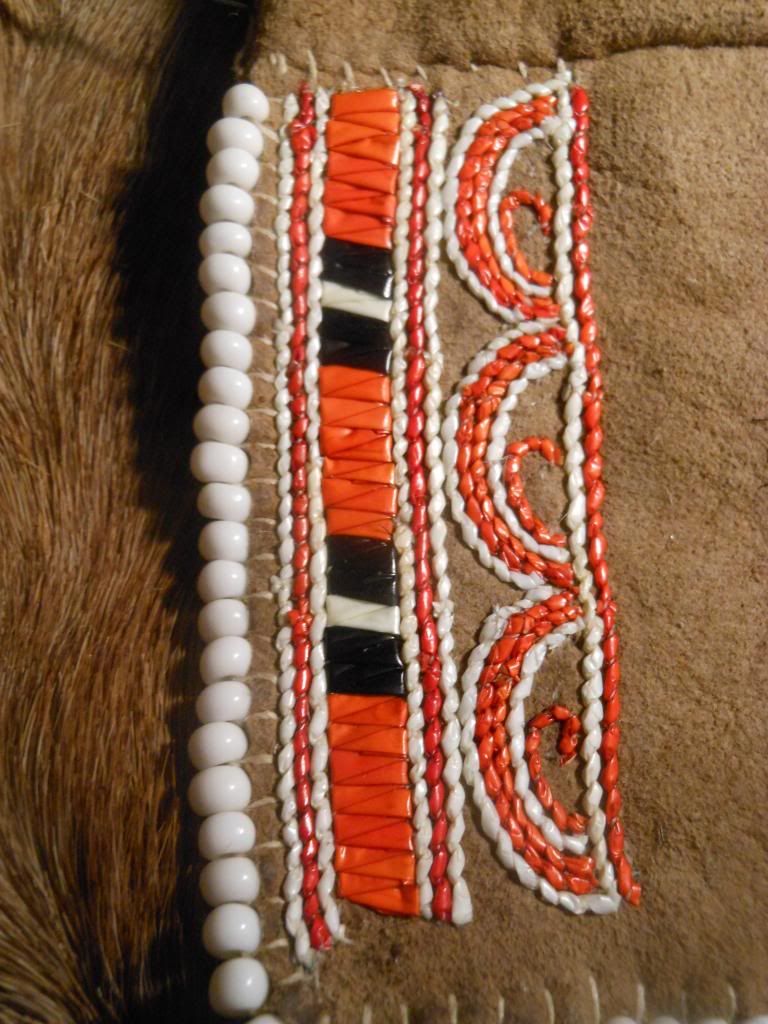naturally dyed Porcy quills
- Thread starter walkswithnomoccasins
- Start date
-
Come along to the amazing Summer Moot (21st July - 2nd August), a festival of bushcrafting and camping in a beautiful woodland PLEASE CLICK HERE for more information.
You are using an out of date browser. It may not display this or other websites correctly.
You should upgrade or use an alternative browser.
You should upgrade or use an alternative browser.
Those look great. What do you use them for?
That's what I thought too
Great work mate!
That's a very orange orange from madder.....I get pinks, peaches and deep, dark reds from madder. What do you use as mordant ? without any I get pale pink or peach.
Very interesting to see; thank you for the photos
cheers,
Toddy
hey toddy These were just simmered in distilled vinegar for 30 mins before going in the dye bath. If you use Alum it gives you the slightly more red spectrum orange on the pouch
I think I'm going to have a play 
Like you I find alum gives me red shades, but I don't get orange. I do get peachy ones from the used dyebath though. Copper gives rich dark plum colours and iron gives dark maroon shades.
Do you do any overdyeing ? Yellow into indigo gives green for instance ? or madder red into indigo gives me purples.
I knew of porcupine quills being used for fishing floats, but I didn't know that you could do such fine work with them.
We learn something everyday, we really do
atb,
M
Like you I find alum gives me red shades, but I don't get orange. I do get peachy ones from the used dyebath though. Copper gives rich dark plum colours and iron gives dark maroon shades.
Do you do any overdyeing ? Yellow into indigo gives green for instance ? or madder red into indigo gives me purples.
I knew of porcupine quills being used for fishing floats, but I didn't know that you could do such fine work with them.
We learn something everyday, we really do
atb,
M
I have done some over-dying in the past trying to get a naturally dyed black. but in the end found out the iron and wood ash trick from a friend in the USA. Soon hope to do some early 19th c style floral work so will be overdying some form of yellow with indigo (probably golden rod). I try and produce the items as authentically as possible and aside from the nymo thread I use for the quillwork all the other materials are correct to the mid to late 18th century. I plan to use a lot more north American dye stuffs and will be planting a dye garden in the spring with the species in question.
I bought a book years back, A Dyer's Garden, or somesuch title, but it was American and many of the plants just won't grow here. Interesting though  and the author did a matching book called a weaver's garden that is full of detail, such as which plants to use as soap.
and the author did a matching book called a weaver's garden that is full of detail, such as which plants to use as soap.
This is the first one....
http://www.amazon.com/A-Dyers-Garden-Rita-Buchanan/dp/B00DF1W5VI
Did NativeTech not have a long article on natural dyes too though ?
atb,
M
This is the first one....
http://www.amazon.com/A-Dyers-Garden-Rita-Buchanan/dp/B00DF1W5VI
Did NativeTech not have a long article on natural dyes too though ?
atb,
M
Yep i had forgotten about that. . Have had to do a fair amount of research into dye plants that are present in the north east. My main area of interest is the woodland peoples. Due to similarities in climate a lot of the woodland plants can be grown on our bleak shores
. Have had to do a fair amount of research into dye plants that are present in the north east. My main area of interest is the woodland peoples. Due to similarities in climate a lot of the woodland plants can be grown on our bleak shores 
Should do, should do 
Dry and hot/sun loving ones just don't like our heavy, wet soil and overcast skies.
Dyes and natural colours are things I find really interesting well over 70% of British dyestuffs will give yellow, and those yellows can be adjusted or overdyed. Your black is very good, to get that from our native plants I have to use oakgalls or bark and iron. Iron weakens wool though, so it's a niggle to get it just right.
well over 70% of British dyestuffs will give yellow, and those yellows can be adjusted or overdyed. Your black is very good, to get that from our native plants I have to use oakgalls or bark and iron. Iron weakens wool though, so it's a niggle to get it just right.
I've been doing a lot of corndolliy weaving and have been trying to get good natural colours on the straws. Not as crisp as I'd like so far. Your quill colours are very crisp
cheers,
M
Dry and hot/sun loving ones just don't like our heavy, wet soil and overcast skies.
Dyes and natural colours are things I find really interesting
I've been doing a lot of corndolliy weaving and have been trying to get good natural colours on the straws. Not as crisp as I'd like so far. Your quill colours are very crisp
cheers,
M
That quill work is excellent!
In the book "Crafts of the North American Indians - a craftsman's manual" Richard c Schneider goes into a deal of detail about quill work on Birchbark and barely mentions quilled buckskin - though the chapter on beadwork also mentions quillwork in passing.
I love beadwork - African and American - and that quillwork looks even better!
In the book "Crafts of the North American Indians - a craftsman's manual" Richard c Schneider goes into a deal of detail about quill work on Birchbark and barely mentions quilled buckskin - though the chapter on beadwork also mentions quillwork in passing.
I love beadwork - African and American - and that quillwork looks even better!
Similar threads
- Replies
- 3
- Views
- 899
- Replies
- 11
- Views
- 4K
- Replies
- 67
- Views
- 39K
- Replies
- 61
- Views
- 15K


